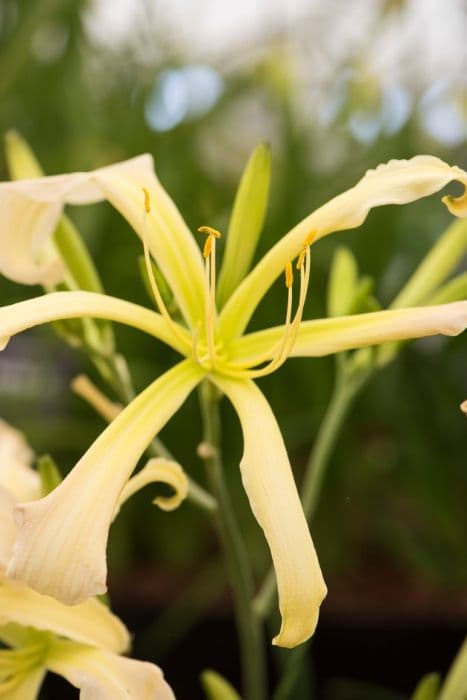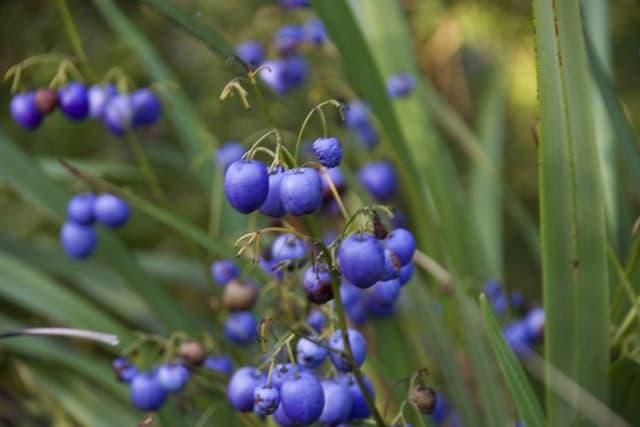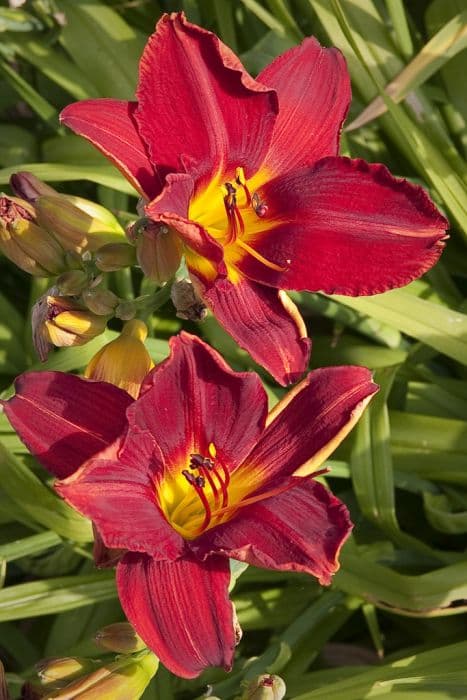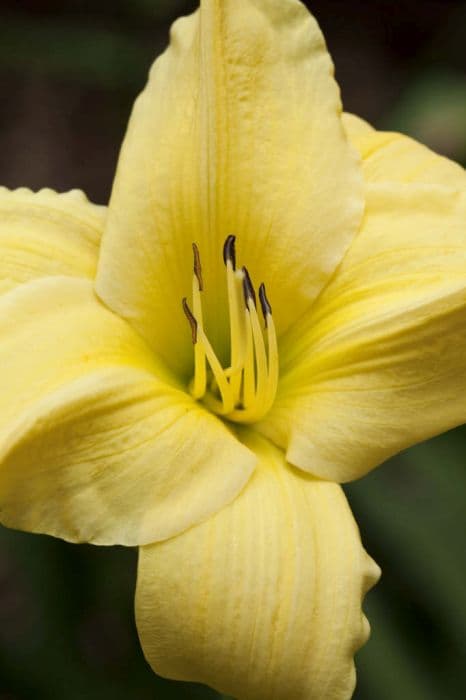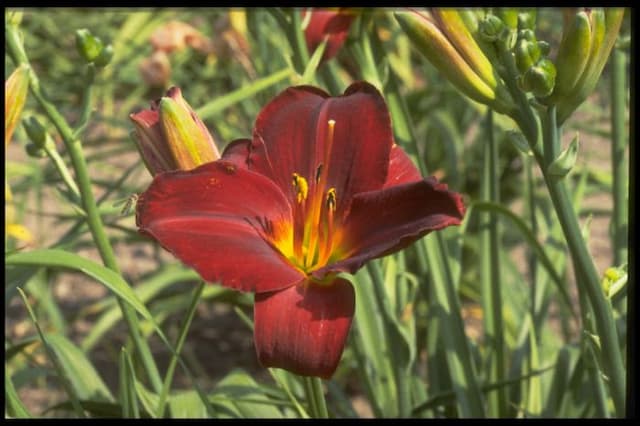Daylily Hemerocallis 'I Love to Tell the Story'

ABOUT
The plant known as "I Love to Tell the Story" is a cultivar of the common daylily, characterized by its striking flowers and foliage that brings a vibrant touch to gardens. The blooms are the main attraction, typically featuring large, trumpet-shaped flowers that command attention. The petals are often ruffled, adding a sense of depth and complexity to the flower's appearance. These daylilies exhibit a rich color palette, often with the petals displaying a gradient of shades or having contrasting colored throats, the central part of the flower where the petals fuse together and connect to the stem. The blossoms, emerging from sturdy flower scapes, are a draw for pollinators like bees and butterflies. The foliage forms a lush, grassy clump at the base, with long, narrow leaves that arch gracefully. The leaves have a smooth texture and a green color that may be bright or deeper shades depending on the variety. Overall, the plant has a robust, clumping form, and its showy blooms and appealing foliage make it a favorite among gardeners for adding color and texture to planting beds and borders.
About this plant
 Names
NamesFamily
Hemerocallidaceae
Synonyms
Daylily
Common names
Hemerocallis 'I Love to Tell the Story'.
 Toxicity
ToxicityTo humans
Daylilies are not generally considered toxic to humans. However, some individuals may be allergic or sensitive to them, which could result in mild stomach upset if ingested. It is important to note that plants may vary in their toxicity based on individual reactions, preparation, and amount consumed.
To pets
Daylilies are known to be toxic to cats, leading to potentially life-threatening symptoms if ingested. The consequences of ingesting daylilies can include vomiting, lethargy, kidney failure, and in severe cases, death. It is essential to prevent cats from having any access to daylilies due to their high toxicity to felines.
 Characteristics
CharacteristicsLife cycle
Perennials
Foliage type
Deciduous
Color of leaves
Green
Flower color
Mixed
Height
2 feet (0.61 m)
Spread
2 feet (0.61 m)
Plant type
Herb
Hardiness zones
3-9
Native area
Asia
Benefits
 General Benefits
General Benefits- Easy to Grow: The Daylily is known for its hardiness and ability to thrive in a variety of soil conditions, making it ideal for beginners or low-maintenance gardens.
- Drought Tolerant: Once established, Daylilies can withstand periods of low water, reducing the need for frequent irrigation.
- Pest Resistant: They are relatively resistant to pests, which means fewer chemical interventions are needed.
- Adaptable: Daylilies can grow in a range of light conditions, from full sun to partial shade, adapting easily to different garden locations.
- Long Blooming: They have a long flowering period, which can extend from early summer to fall, offering extended visual interest.
- Attracts Pollinators: The flowers attract butterflies and bees, aiding in the pollination of gardens.
- Variety of Colors: Daylilies come in a myriad of colors, providing an assortment of aesthetic options for garden design.
- Propagates Easily: They can be easily divided to propagate new plants, making them economical and a great way to expand your garden or share with others.
- Tolerates Poor Soil: Daylilies can tolerate less than ideal soil conditions, including clay or sandy soils.
- Minimal Care: Besides occasional watering and optional deadheading, they require little regular care, making them ideal for low-maintenance landscapes.
 Medical Properties
Medical PropertiesThis plant is not used for medical purposes.
 Air-purifying Qualities
Air-purifying QualitiesThis plant is not specifically known for air purifying qualities.
 Other Uses
Other Uses- The flower petals of the daylily can be used as a natural food coloring to impart a soft yellow hue to dishes and pastries.
- Daylily blooms can be stuffed with sweet or savory fillings, serving as an edible, decorative container for appetizers or desserts.
- The sturdy leaves of the daylily can be woven into small baskets or mats, utilizing their natural flexibility when green.
- Pressed daylily flowers can be used in decorative crafts such as homemade paper, bookmarks or framed botanical art.
- The fibrous roots of daylilies can be used in garden compost to enhance soil texture and nutrient content.
- With their ability to tolerate wet conditions, daylilies can be planted to help with soil erosion control on slopes and riverbanks.
- The plant's dried seed pods can be used in floral arrangements to add an interesting, textural element.
- Daylily flowers can be frozen in ice cubes to add a touch of elegance and color to summer drinks and punch bowls.
- The plant can be used as a natural dye for fabrics, providing a range of colors from yellow to green depending on the mordant used.
- Daylily flowers are a source of food for certain animals, such as deer and rabbits, and can be planted to distract them from more valuable crops or garden plants.
Interesting Facts
 Feng Shui
Feng ShuiThe Daylily is not used in Feng Shui practice.
 Zodiac Sign Compitability
Zodiac Sign CompitabilityThe Daylily is not used in astrology practice.
 Plant Symbolism
Plant Symbolism- Daylily (Hemerocallis 'I Love to Tell the Story'): The daylily is often associated with the ephemeral nature of life, as each bloom typically lasts for just a day, symbolizing the fleeting moments that we should cherish.
- Beauty: Daylilies come in a variety of colors and forms, and their striking appearance symbolizes beauty and the appreciation of it.
- Motherhood: In Chinese culture, daylilies represent motherhood and fertility due to their abundant and multiple blooms.
- Renewal: Since the daylily can produce new flowers day after day, it is often seen as a sign of renewal and the continuous cycle of life.
- Forgiveness: With its daily cycle of blooming and fading, the daylily can also symbolize forgiveness and forgetting past grudges or sorrows, essentially starting each day anew.
 Water
WaterDaylilies, like Hemerocallis 'I Love to Tell the Story', prefer consistent moisture, especially during their active growing season in spring and summer. Water deeply once a week, providing about an inch of water each time, which correlates to approximately 0.6 gallons per square yard of soil area. During periods of drought or extreme heat, you may need to water twice a week. Reduce watering in the fall to help the plants harden off for winter, and in winter, watering may only be necessary during unseasonably dry spells. It's best to water in the morning to allow foliage to dry, reducing the risk of disease.
 Light
LightDaylilies thrive in full sunlight, requiring at least six hours of direct sun per day. Hemerocallis 'I Love to Tell the Story' will perform best in a location that receives ample morning sunlight and some shade during the hottest part of the afternoon. They can tolerate partial shade but may produce fewer flowers and can become more prone to disease due to less vigorous growth.
 Temperature
TemperatureDaylilies are hardy plants that can tolerate a wide range of temperatures, but they perform best when daytime temperatures are between 60 to 75 degrees Fahrenheit. Hemerocallis 'I Love to Tell the Story' can survive minimum temperatures down to -20 degrees Fahrenheit and maximum temperatures well into the 90s, but prolonged exposure outside this range may stress the plants and affect flowering.
 Pruning
PruningPrune Hemerocallis 'I Love to Tell the Story' throughout the growing season to remove spent flower stalks and keep the plant tidy. After flowering, cut back the foliage of daylilies if it becomes brown or damaged. The best time for significant pruning is early spring or immediately after the plant finishes blooming, which can help rejuvenate the plants and encourage a tidy appearance.
 Cleaning
CleaningAs needed
 Soil
SoilDaylilies thrive in well-draining soil with a slightly acidic to neutral pH of 6.0 to 6.8. A mixture of loamy garden soil, compost, and a bit of sand or perlite to improve drainage makes for the best soil mix.
 Repotting
RepottingDaylilies (Hemerocallis) typically don't need frequent repotting. They can be divided and repotted every 3-5 years or when they become overcrowded in their current space.
 Humidity & Misting
Humidity & MistingDaylilies prefer moderate ambient humidity but are quite adaptable and can tolerate a range from low to high humidity without much issue as long as they are well-watered.
 Suitable locations
Suitable locationsIndoor
Place in bright light, ensure pot has drainage, water moderately.
Outdoor
Plant in full sun to part shade, ensure well-draining soil.
Hardiness zone
3-9 USDA
 Life cycle
Life cycleThe Daylily 'I Love to Tell the Story' begins its life cycle as a seed, which when planted in the ground, germinates and develops a small root system and a shoot that pushes through the soil. The shoot grows into a clump of strap-like leaves and, over time, these become established as a perennial base. From this clump, stalks known as scapes emerge, bearing buds that will bloom into the plant's distinctive trumpet-shaped flowers, typically during the summer months. Each flower lasts only for one day, opening in the morning and withering by nightfall, hence the name "daylily." After flowering, if pollination has occurred, seed pods may form which eventually dry and release seeds for the next generation. During the winter or cooler months, the daylily may die back, entering a period of dormancy, but the roots and base of the plant survive, ready to regrow when conditions become favorable again.
 Propogation
PropogationPropogation time
Early Spring
The Hemerocallis 'I Love to Tell the Story', commonly known as a daylily, is best propagated by division. This is typically done right after the plant finishes blooming, which usually occurs in late summer to early fall. To propagate by division, carefully dig around the plant, lift it from the ground, and shake or rinse off excess soil. Look for natural divisions in the root clump, and gently pull apart or cut through the roots to separate the plant into smaller sections, each with a fan of leaves and a portion of the root system. After division, replant the sections at the same depth they were growing before, spacing them about 18 to 24 inches apart (45 to 60 centimeters) to allow room for growth. Water the newly planted divisions well, and they should establish themselves quickly and resume growth. This method is preferred for its simplicity and the fact that it helps to rejuvenate older clumps that may have become too dense, ensuring vigorous blooms for the following seasons.

